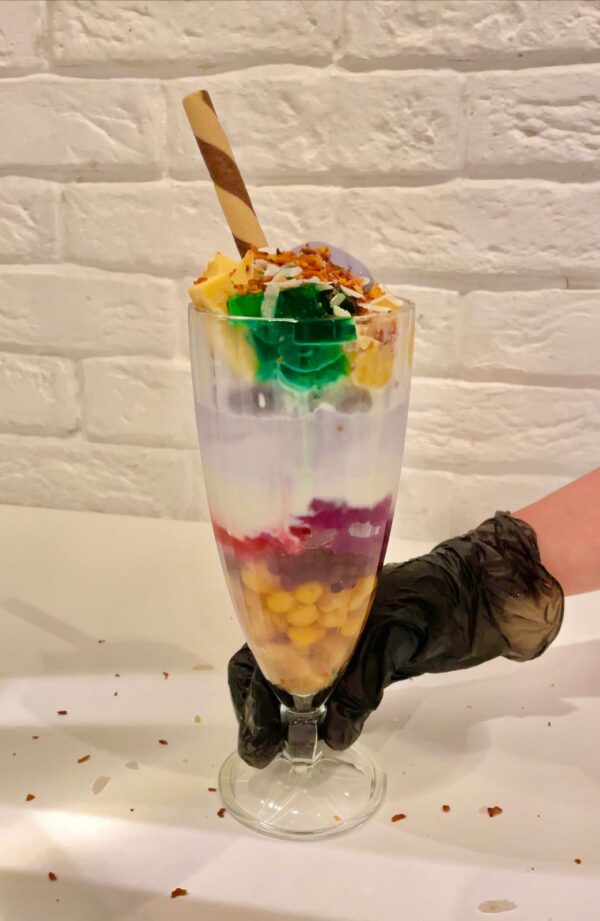
Exploring Halo Halo’s Origins: From the Philippines to the Global Stage
Halo Halo Desert, originating from its humble roots in the Philippines, has become a must have desert worldwide. Known for its colors and an amazing blend of flavors, the name of this iconic Filipino dessert translates to “mix-mix” in English.
It is a combination of different ingredients, where a foundation is made up with shaved ice and then other sweet ingredients are added like sweetened beans, coconut sport, jackfruit, and banana topped with a scoop of ube ice cream and evaporated milk.
What is the story behind this creation? Halo Halo, deeply rooted in the history of the Philippines draws inspiration from a variety of influences including the flavors of Japan and America. It’s can be traced back to the time before colonization when ingenious Filipinos combined crushed rice, coconut and various local ingredients to create treats. This tradition continues to bring joy to people today showcasing the tapestry of cuisine.
Throughout the years, it has undergone an evolution embracing ingredients introduced by Spanish and American settlers. This transformation has given birth to its modern-day version that has captivated hearts worldwide for its blend of flavors and expert mixing techniques.
The Historical Background of Halo Halo
The roots and history of Halo Halo can be traced back to colonial times in the Philippines. During this era Filipinos would craft treats by blending crushed rice, coconut and a selection of ingredients. These early editions of this desert were simple yet provided needed relief from the scorching climate.
Over time, the Philippines has developed into a cultural melting pot, playing a significant role in shaping the evolution of this desert. With the arrival of American settlers, new ingredients found their way into this dessert. The Spanish people added a range of different fruits and jellies, while the Americans introduced the concept of using shaved ice as a foundation. The Halo Halo we have today is the result of contributions from different cultures over time.
Ingredients and Preparation
To create Halo Halo, being by filling a tall glass or bowl with shaved ice, allowing all the other ingredients to shine. Then add sweetened beans, coconut sport (macapuno) jackfruit (langka) and banana. To elevate your taste experience even further, add a scoop of ube ice cream on the top. Ube, an ingredient from the Philippines known for its purple color and distinctive taste, brings a special taste to the desert. To complete this combination, add evaporated milk to enhance the taste of the entire dessert.
Popular Variations of Halo Halo
While Filipinos still hold a special place in their hearts for the traditional version of Halo Halo, there are also many different variations of this dessert worth exploring. Each unique version offers flavors and ingredients that invite dessert enthusiasts on an adventure to discover exciting taste combinations.
A renowned variation well worth exploring is the ‘Halo Halo Special,’ which includes leche flan (caramel custard), chewy sago (tapioca pearls), and crunchy pinipig (crisped rice) to elevate the dessert’s texture and infuse it with a touch of indulgence. These fantastic additions truly enhance the dessert’s flavour. Alternatively, consider trying the ‘Mais Con Hielo,’ in which certain sweet elements are substituted with corn kernels, resulting in a fusion of sweet and savory sensations.
For those seeking a lighter and fresher twist, consider the ‘Fruit Salad Halo Halo.’ This version boasts a medley of fruits, including ripe mangoes, bananas, and juicy strawberries, instead of the sweetened beans and jackfruit. This refreshing adaptation adds a new dimension to experience this sweet dish while still capturing the cherished essence that makes it so beloved.
Cultural Significance
In Filipino culture, it holds a special place, symbolizing unity and togetherness. It brings back memories from childhood and brings happiness while fostering lasting connections with friends and loved ones.
It is not only significant in the Philippines, but it has also gained popularity internationally. It has become an symbol of food allowing people to experience the delicious heritage of the country. Numerous Filipino restaurants and food establishments around the world proudly feature this sweet dish on their menus to attract desert lovers.
Global Presence
It has gained popularity worldwide. In the United States of America, it brings a sense of home to Filipino immigrants and can easily be found in Asian restaurants. It has even made its mark in mainstream food culture appearing on fusion restaurant menus and winning over food lovers.
Halo halo has also made a significant impact outside of the United States, leaving its mark in different corners of the globe. Filipino communities in Canada, Australia, United Kingdom, United Arab Emirates, and the Kingdom of Saudi Arabia have introduced it to their nations, giving locals a taste of their vibrant culture.
This desert has gained popularity establishing itself as a symbol of Filipino culture and tradition. It has been prominently showcased in Filipino movies, television shows and music videos attracting viewers with its appearance and vibrant hues. This dessert frequently steals the limelight, in food photography and social media updates. It brings people together, ignites conversations about culture and heritage. It has also become quite popular among travel bloggers and food lovers worldwide.
